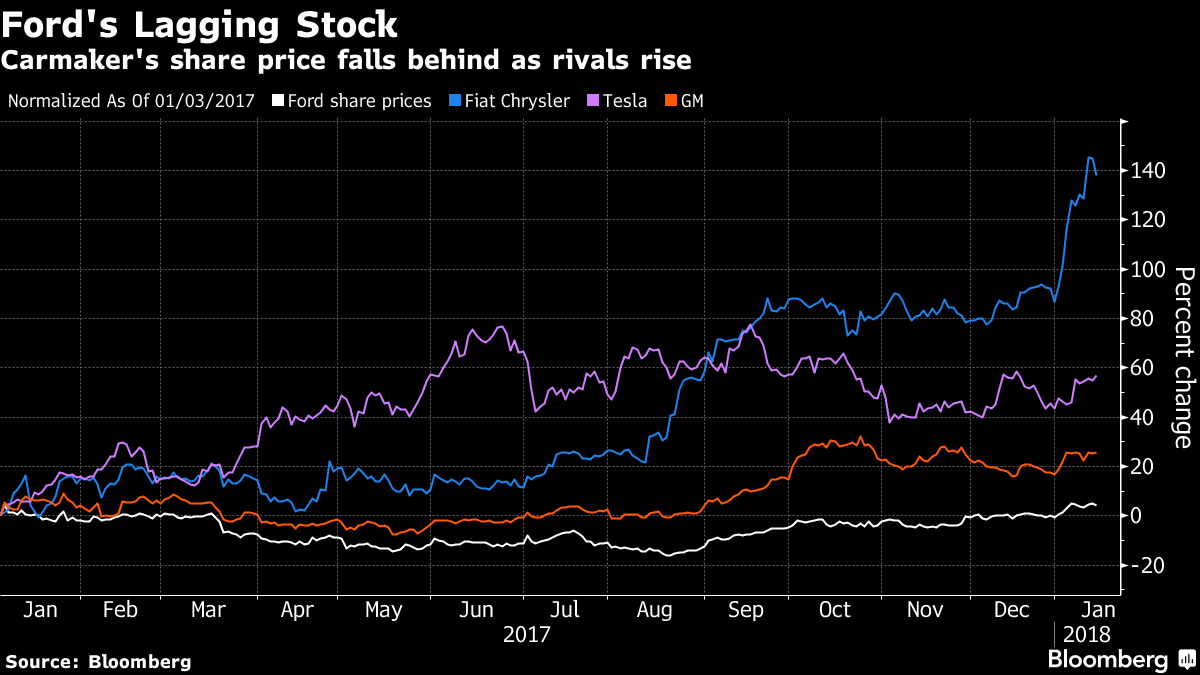Ford Motor Co., the more than century-old company that was first to make cars for the masses, is calling off its pursuit of everyman sedan buyers.
The company responsible for putting the world on wheels with Henry Ford’s then-innovative assembly line will pivot away from being a full-line automaker, shrinking its passenger-car lineup and shifting only to low-volume, high-margin models.
The reason? Years of coming up short on a longheld profit-margin target. Earnings disappointments cost former Chief Executive Officer Mark Fields his job in May, and his replacement Jim Hackett has since laid out plans to reorient the company around lucrative sport utility vehicles and pickups, plus play catch-up on the trends that are sweeping the auto industry: the rise of electric, autonomous, connected and shared vehicles.
“Let’s be clear: We are not satisfied with our performance,” Chief Financial Officer Bob Shanks told analysts Tuesday. “For the past seven months, we have undergone a rigorous assessment to ensure we are fit as a business and are making the choices that will create the Ford of tomorrow.”
Read more: Detroit Ditching Cars to Mint Money Off Trucks
Before delivering a presentation at the Deutsche Bank Auto Industry Conference, Shanks warned that adjusted profit will fall this year to $1.45 to $1.70 a share, down from about $1.78 last year. While Wall Street had been expecting a drop from 2017, the low end of the company’s guidance is worse than what
analysts were anticipating.
Margin Mishaps
Ford’s automotive business earned just a 5 percent profit margin last year, less than its average since 2010 of about 6 percent, according to Shanks. The company hasn’t achieved its 8 percent goal in any year since the global recession, he said.
The automaker flagged its expectation for weaker earnings two days after Executive Chairman Bill Ford said the company founded by his grandfather is going
“all in” on electric cars. Ford kicked off this week’s Detroit auto show by pledging to invest $11 billion to bring 40 electrified vehicles to market by 2022.
Hackett, 62, last year took over an automaker that lacks a model to compete with cars like General Motors Co.’s Chevrolet Bolt or
Tesla Inc.’s Model S. On Tuesday, Hackett rejected the notion that Ford is behind.
“Ford is going to aim ahead to where it has to be,” he said at the conference Automotive News World Congress in Detroit. “Because it has to be ahead in order for people to believe our strategy isn’t about catching up to somebody else.”
‘Must Evolve’
Executives did, however, acknowledge that Ford has to change course. That will include cutting car lines that no longer sell well.
“We know we must evolve to be even more competitive and narrow our full line of nameplates in all markets, to a more focused lineup that delivers stronger, more profitable growth, with better returns,” Jim Farley, Ford’s president of global markets, said in a statement.

Ford shares fell 2 percent to $12.84 after the close of regular trading in New York. The stock rose just 3 percent in 2017, trailing Tesla’s 46 percent surge and GM’s 18 percent jump.
The biggest factors contributing to Ford’s expectation for lower profit this year are the rising price of commodities, including steel and aluminum, and adverse effects from currency exchange rates, in part due to Brexit. Those costs represent a $1.6 billion headwind to earnings this year, Shanks said.
Prolonged Payback
The profit forecast prolongs the payback from spending on autonomous vehicles and other technology that Hackett’s predecessor, Mark Fields, had been promising to investors before his ouster in May. Profit will rebound over time, Shanks said in a phone interview.
“We certainly see us on a path toward the margins that we have been targeting for a long time,” Shanks said, referring to the 8 percent target. “Not this year or next year, but within the next several years.”
In addition to electrifying its lineup, Ford is reallocating investment toward crossovers and rugged off-roaders amid slumping demand for passenger cars in its home market. The Lincoln luxury brand, already highly reliant on models like the Navigator, will orient toward SUVs in the future.
Ford projects it will boost the share of its sales from SUVs by 10 percentage points — all at cars’ expense — over the next couple years to cash in on more lucrative models that American consumers want.

“We’ll have more utilities,” Shanks said. “We will be simplifying, if you will, our participation in the car segments to move into sub-segments that have more margin and are more attractive.”
GM
surprised Wall Street earlier Tuesday by predicting steady profit this year to be followed by another earnings jump in 2019. A redesigned Chevrolet Silverado pickup and fresh crop of crossovers are helping fund CEO Mary Barra’s ambitious plans to put robo-taxis on the road in a ride-sharing fleet next year and roll out 20 all-electric models by 2023.
Ford also announced it will start being more transparent about its own bets on mobility. Within the slides Shanks presented, the company disclosed it lost about $300 million in this business last year.
